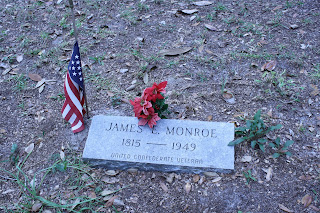"What Is It???" Wednesday: Curious Case of a Confederate Veteran
Yes, you are reading that right. According to Jay Hoar's The South's Last Boys in Gray (1986), Mr. James Monroe of Jacksonville was the longest living Civil War veteran. If you're a researcher, it's worth digging a little deeper as there are interesting references in print about Mr. Monroe. Post what you find in the comments section! And what about the headstone? Any guesses on when that marker was placed in the ground? If you can help me find a reasonable answer to this mystery and can correctly guess the final resting place of Mr. Monroe, it's worth one of our last T'Omb It May Concern T-shirts!
WHAT IS IT???
WHAT'S GOING ON???
 |
| Me in my former life, State Mound, KY. |
Last week's WIIW answer: Correct, its a housewife! A housewife to a soldier was a sewing kit that they carried with them to repair damage to a uniform. The housewife we recovered at State Mound in Frankfort, KY, was found along with the remains of a Mexican War veteran, who survived that war but was ultimately assassinated (stabbed). The housewife was found wrapped in wool, presumed to be the back of the uniform. I had a high school student volunteering with me that summer, and as part of his project we began minor conservation of the bundle to see if it was more than just an iron concretion. And it was! Pins, buttons, and a buckle--perhaps tied together with string long decomposed--was observed after clearing away some of the rust.
Here's the section of the technical report:
Housewife Sewing Kit
During the cleaning of the textiles from Green’s burial another interesting artifact was recovered: a bundle of straight pins, two buttons, and a buckle. There are two interpretations for the use of this compound artifact. One interpretation is that this artifact represents a sewing kit, affectionately termed a housewife, that was common during the Civil War. Most housewives found in museum collections or used by re-enactors, however, are larger and generally wrapped in fabric which would have separated the items from each other. Alternatively, this could be a bundle used to pull the uniform taut behind the back for presentation of the dead. However, this second interpretation does not adequately address why so many clothing type artifacts, such as the buckle and two buttons, would be found bundled together in fabric.
As fun as the project was, the best part was the reburial ceremony. To see the lives of those men as relevant in 2005 as they were more than a hundred years ago; priceless.
 |
| Historic veterans reburied in donated caskets. |
 |
| My former boss Dave Pollack doing public archaeology, graveside. |
 |
| JAG for Kentucky National Guard among distinguished speakers. |
 |
| Honor guard, choir, the works! |
Text: Sarah Miller, FPAN staff with excerpt from "Archaeological Investigation of the State Mound, Frankfort, Kentucky" by M. Jay Stottman and David Pollack with Contributions by Peter E. Killoran, Sarah E. Miller, Phillip B. Mink, Christina A. Pappas, Eric Schlarb, and Lori Stahlgren. Kentucky Archaeological Survey (2005).
Photos: Sarah Miller, FPAN staff and Dave McBride, formerly KAS staff
